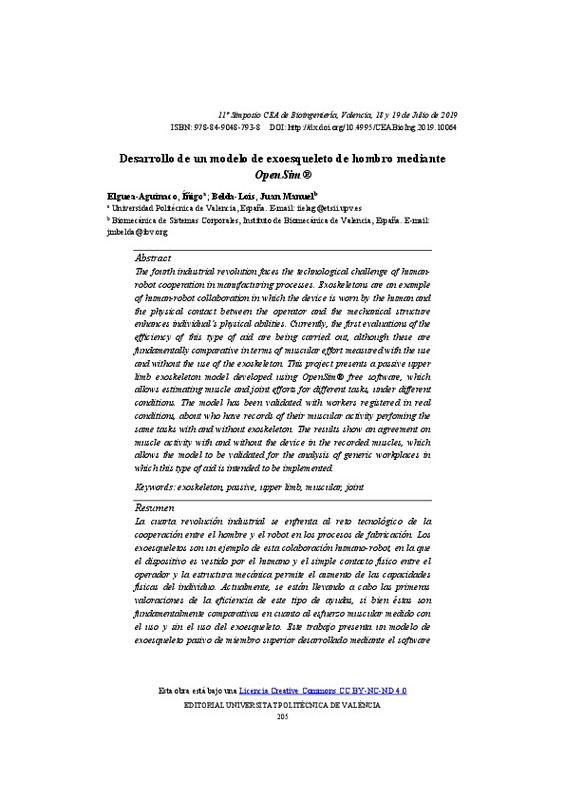JavaScript is disabled for your browser. Some features of this site may not work without it.
Buscar en RiuNet
Listar
Mi cuenta
Estadísticas
Ayuda RiuNet
Admin. UPV
Elaboración de un Modelo de Exoesqueleto de Hombro mediante OpenSim
Mostrar el registro sencillo del ítem
Ficheros en el ítem
| dc.contributor.author | Elguea Aguinaco, Íñigo
|
es_ES |
| dc.contributor.author | Belda Lois, Juan Manuel
|
es_ES |
| dc.date.accessioned | 2019-11-14T13:42:00Z | |
| dc.date.available | 2019-11-14T13:42:00Z | |
| dc.date.issued | 2019-11-13 | |
| dc.identifier.isbn | 9788490487938 | |
| dc.identifier.uri | http://hdl.handle.net/10251/131063 | |
| dc.description.abstract | [ES] La cuarta revolución industrial se enfrenta al reto tecnológico de la cooperación entre el hombre y el robot en los procesos de fabricación. Los exoesqueletos son un ejemplo de esta colaboración humano-robot, en la que el dispositivo es vestido por el humano y el simple contacto físico entre el operador y la estructura mecánica permite el aumento de las capacidades físicas del individuo. [1] Actualmente, se están llevando a cabo las primeras valoraciones de la eficiencia de este tipo de ayudas, si bien éstas son fundamentalmente comparativas en cuanto al esfuerzo muscular medido con el uso y sin el uso del exoesqueleto. Este Trabajo de Fin de Máster presenta un modelo de exoesqueleto pasivo de miembro superior desarrollado mediante el software libre OpenSim, el cual permite estimar los esfuerzos musculares y articulares para distintas tareas y en distintas condiciones. El modelo se ha validado con trabajadores registrados en condiciones reales, de los que se disponen registros de su actividad muscular realizando las mismas tareas con exoesqueleto y sin él. Los resultados muestran un buen acuerdo en la actividad muscular con y sin el dispositivo en los músculos registrados, lo que permite validar el modelo para el análisis de puestos de trabajo genéricos en los que se pretenda implantar este tipo de ayudas. | es_ES |
| dc.description.abstract | [EN] The fourth industrial revolution faces the technological challenge of humanrobot cooperation in manufacturing processes. Exoskeletons are an example of human-robot collaboration in which the device is worn by the human and the physical contact between the operator and the mechanical structure enhances individual´s physical abilities. Currently, the first evaluations of the efficiency of this type of aid are being carried out, although these are fundamentally comparative in terms of muscular effort measured with the use and without the use of the exoskeleton. This project presents a passive upper limb exoskeleton model developed using OpenSim® free software, which allows estimating muscle and joint efforts for different tasks, under different conditions. The model has been validated with workers registered in real conditions, about who have records of their muscular activity perfoming the same tasks with and without exoskeleton. The results show an agreement on muscle activity with and without the device in the recorded muscles, which allows the model to be validated for the analysis of generic workplaces in which this type of aid is intended to be implemented. | es_ES |
| dc.format.extent | 16 | es_ES |
| dc.language | Español | es_ES |
| dc.publisher | Editorial Universitat Politècnica de València | es_ES |
| dc.relation.ispartof | 11º Simposio CEA de Bioingeniería | |
| dc.rights | Reconocimiento - No comercial - Sin obra derivada (by-nc-nd) | es_ES |
| dc.subject | Bioingeniería | es_ES |
| dc.subject | Interfaces cerebro-máquina | es_ES |
| dc.subject | Tecnología | es_ES |
| dc.subject | Rehabilitación | es_ES |
| dc.subject | Asistencia | es_ES |
| dc.subject | Biomecánica | es_ES |
| dc.subject | Bioseñales | es_ES |
| dc.subject | Robótica | es_ES |
| dc.subject | Imagen médica | es_ES |
| dc.subject | Sensores | es_ES |
| dc.subject | Instrumentación | es_ES |
| dc.subject | Modelado | es_ES |
| dc.subject | Simulación | es_ES |
| dc.subject | Control | es_ES |
| dc.subject | Telemedicina | es_ES |
| dc.subject | Biomateriales | es_ES |
| dc.subject | Transferencia | es_ES |
| dc.subject | Experiencia clínica | es_ES |
| dc.title | Elaboración de un Modelo de Exoesqueleto de Hombro mediante OpenSim | es_ES |
| dc.type | Capítulo de libro | es_ES |
| dc.type | Comunicación en congreso | es_ES |
| dc.identifier.doi | 10.4995/CEABioIng.2019.10064 | |
| dc.rights.accessRights | Abierto | es_ES |
| dc.contributor.affiliation | Universitat Politècnica de València. Departamento de Ingeniería Mecánica y de Materiales - Departament d'Enginyeria Mecànica i de Materials | es_ES |
| dc.contributor.affiliation | Universitat Politècnica de València. Escuela Técnica Superior de Ingenieros Industriales - Escola Tècnica Superior d'Enginyers Industrials | es_ES |
| dc.description.bibliographicCitation | Elguea Aguinaco, Í.; Belda Lois, JM. (2019). Elaboración de un Modelo de Exoesqueleto de Hombro mediante OpenSim. En 11º Simposio CEA de Bioingeniería. Editorial Universitat Politècnica de València. 205-220. https://doi.org/10.4995/CEABioIng.2019.10064 | es_ES |
| dc.description.accrualMethod | OCS | es_ES |
| dc.relation.conferencename | 11 Simposio CEA de Bioingeniería | es_ES |
| dc.relation.conferencedate | Julio 18-19,2019 | es_ES |
| dc.relation.conferenceplace | Valencia, Spain | es_ES |
| dc.relation.publisherversion | http://ocs.editorial.upv.es/index.php/CEABioIng/CEABioIng/paper/view/10064 | es_ES |
| dc.description.upvformatpinicio | 205 | es_ES |
| dc.description.upvformatpfin | 220 | es_ES |
| dc.type.version | info:eu-repo/semantics/publishedVersion | es_ES |
| dc.relation.pasarela | OCS\10064 | es_ES |








